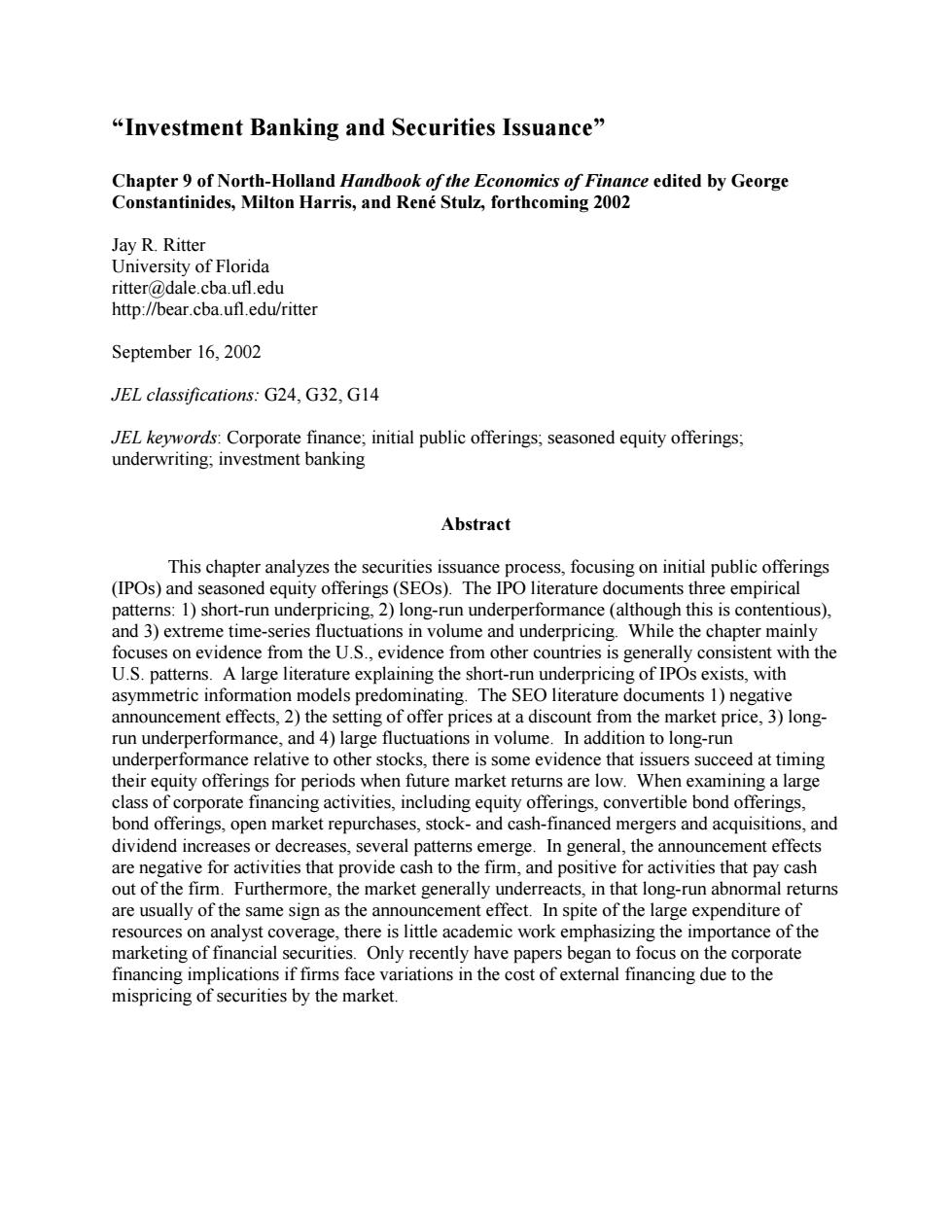正在加载图片...

"Investment Banking and Securities Issuance" Chapter 9 of North-Holland Handbook ofthe Economics of Finance edited by George Constantinides,Milton Harris,and Rene Stulz,forthcoming 2002 Jay R.Ritter University of Florida ritter@dale.cba.ufl.edu http://bear.cba.ufl.edu/ritter September 16,2002 JEL classifications:G24,G32,G14 JEL keywords:Corporate finance;initial public offerings;seasoned equity offerings; underwriting;investment banking Abstract This chapter analyzes the securities issuance process,focusing on initial public offerings (IPOs)and seasoned equity offerings(SEOs).The IPO literature documents three empirical patterns:1)short-run underpricing,2)long-run underperformance(although this is contentious), and 3)extreme time-series fluctuations in volume and underpricing.While the chapter mainly focuses on evidence from the U.S.,evidence from other countries is generally consistent with the U.S.patterns.A large literature explaining the short-run underpricing of IPOs exists,with asymmetric information models predominating.The SEO literature documents 1)negative announcement effects,2)the setting of offer prices at a discount from the market price,3)long- run underperformance,and 4)large fluctuations in volume.In addition to long-run underperformance relative to other stocks,there is some evidence that issuers succeed at timing their equity offerings for periods when future market returns are low.When examining a large class of corporate financing activities,including equity offerings,convertible bond offerings, bond offerings,open market repurchases,stock-and cash-financed mergers and acquisitions,and dividend increases or decreases,several patterns emerge.In general,the announcement effects are negative for activities that provide cash to the firm,and positive for activities that pay cash out of the firm.Furthermore,the market generally underreacts,in that long-run abnormal returns are usually of the same sign as the announcement effect.In spite of the large expenditure of resources on analyst coverage,there is little academic work emphasizing the importance of the marketing of financial securities.Only recently have papers began to focus on the corporate financing implications if firms face variations in the cost of external financing due to the mispricing of securities by the market.“Investment Banking and Securities Issuance” Chapter 9 of North-Holland Handbook of the Economics of Finance edited by George Constantinides, Milton Harris, and René Stulz, forthcoming 2002 Jay R. Ritter University of Florida ritter@dale.cba.ufl.edu http://bear.cba.ufl.edu/ritter September 16, 2002 JEL classifications: G24, G32, G14 JEL keywords: Corporate finance; initial public offerings; seasoned equity offerings; underwriting; investment banking Abstract This chapter analyzes the securities issuance process, focusing on initial public offerings (IPOs) and seasoned equity offerings (SEOs). The IPO literature documents three empirical patterns: 1) short-run underpricing, 2) long-run underperformance (although this is contentious), and 3) extreme time-series fluctuations in volume and underpricing. While the chapter mainly focuses on evidence from the U.S., evidence from other countries is generally consistent with the U.S. patterns. A large literature explaining the short-run underpricing of IPOs exists, with asymmetric information models predominating. The SEO literature documents 1) negative announcement effects, 2) the setting of offer prices at a discount from the market price, 3) longrun underperformance, and 4) large fluctuations in volume. In addition to long-run underperformance relative to other stocks, there is some evidence that issuers succeed at timing their equity offerings for periods when future market returns are low. When examining a large class of corporate financing activities, including equity offerings, convertible bond offerings, bond offerings, open market repurchases, stock- and cash-financed mergers and acquisitions, and dividend increases or decreases, several patterns emerge. In general, the announcement effects are negative for activities that provide cash to the firm, and positive for activities that pay cash out of the firm. Furthermore, the market generally underreacts, in that long-run abnormal returns are usually of the same sign as the announcement effect. In spite of the large expenditure of resources on analyst coverage, there is little academic work emphasizing the importance of the marketing of financial securities. Only recently have papers began to focus on the corporate financing implications if firms face variations in the cost of external financing due to the mispricing of securities by the market